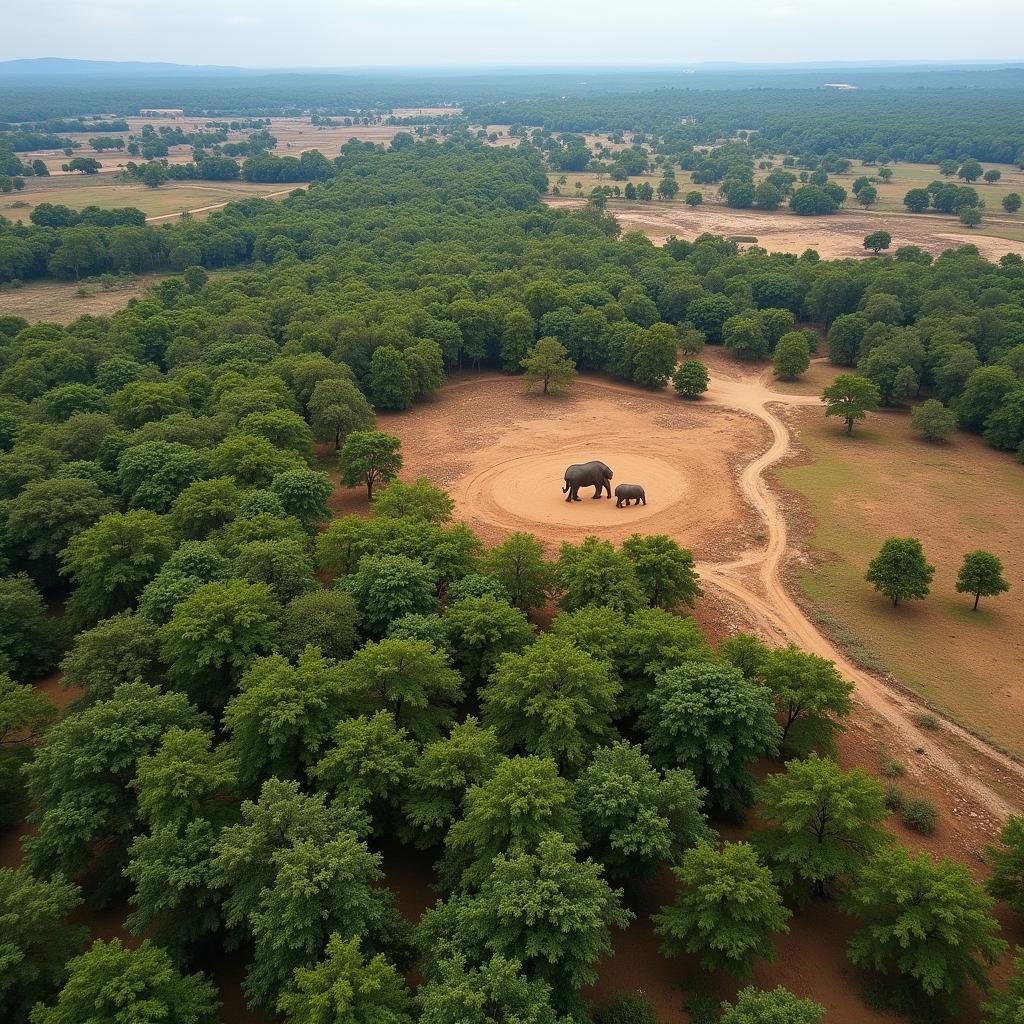African Bush Elephant vs African Forest Elephant: A Detailed Comparison
The African bush elephant and the African forest elephant, while sharing the name “elephant,” possess distinct characteristics that set them apart. This article delves into the fascinating world of these two majestic creatures, exploring their differences in size, habitat, diet, and social behavior. What distinguishes an African bush elephant from its forest-dwelling cousin? Let’s explore the key differences.
Size and Appearance: Spotting the Differences
The African bush elephant, the largest land animal on Earth, dwarfs its forest counterpart. Bush elephants can reach heights of up to 13 feet at the shoulder and weigh over 6 tons, while forest elephants typically reach 8 feet and weigh up to 3 tons. Their tusks also differ. Bush elephants boast larger, more curved tusks, whereas forest elephants have straighter, thinner tusks that point downwards. Ear shape also provides a clue: bush elephants have large, fan-shaped ears, while forest elephants’ ears are smaller and more rounded.
Habitat and Distribution: Where They Roam
As their names suggest, the two species occupy different habitats. Bush elephants roam the vast savannas and grasslands of sub-Saharan Africa, while forest elephants inhabit the dense rainforests of Central and West Africa. Their distinct habitats have shaped their evolutionary paths, leading to specific adaptations. Bush elephants are adapted to open spaces and have larger feet for traversing long distances, whereas forest elephants have adapted to navigating dense vegetation. The african bus elephant thrives in open savannas.
Diet and Foraging: What’s on the Menu?
Both species are herbivores, but their diets vary based on their environment. Bush elephants primarily graze on grasses, while forest elephants browse on leaves, fruits, and bark. Forest elephants play a vital role in seed dispersal within the rainforest ecosystem, contributing to the biodiversity of the forest.
Social Behavior: Family Ties
Both species are highly social animals, living in matriarchal herds. However, forest elephant herds are generally smaller and less structured than those of bush elephants. This difference is likely due to the challenges of navigating and communicating within a dense forest environment. The tight-knit family structure of elephants is crucial for their survival and well-being.
Why are these differences important?
Understanding the distinctions between African bush elephants and African forest elephants is crucial for conservation efforts. Both species face threats from habitat loss, poaching, and human-wildlife conflict. Targeted conservation strategies are needed to address the specific challenges facing each species. For example, protecting forest habitats is critical for the survival of forest elephants, while addressing human-wildlife conflict is crucial for both species.
“Protecting the diverse habitats of both bush and forest elephants is essential for the long-term survival of these magnificent creatures,” says Dr. Anika Patel, a wildlife conservationist specializing in African elephants.
Conservation Concerns: Protecting Giants
Both the African bush elephant and the African forest elephant face significant conservation challenges. Habitat loss due to deforestation and expanding human settlements poses a severe threat. Poaching for ivory remains a major issue, despite international efforts to curb the illegal trade. Both species have seen significant population declines in recent decades, highlighting the urgent need for increased conservation efforts. Learn more about the challenges these magnificent animals face by exploring how the african elephant vs rhino are affected by similar threats.
Conclusion: Two Sides of the Same Coin
The African bush elephant and the African forest elephant, while distinct in many ways, are both integral parts of the African ecosystem. Understanding their differences and the challenges they face is vital for ensuring their long-term survival. By supporting conservation initiatives and promoting sustainable practices, we can help protect these magnificent creatures for generations to come. The african bush elephant female long tusks are particularly prized by poachers, further endangering the species. You can also compare the African forest with another vital ecosystem by reading about the african forest vs amazon forest. Understanding the differences between these two elephant species is crucial for effective conservation efforts.
FAQ
- What is the main difference in size between the two species? Bush elephants are significantly larger than forest elephants.
- Where do forest elephants live? They live in the dense rainforests of Central and West Africa.
- What do bush elephants eat? They primarily graze on grasses.
- How do their tusks differ? Bush elephant tusks are larger and more curved, while forest elephant tusks are straighter and thinner.
- Why are both species endangered? Habitat loss and poaching are the primary threats.
- How do their social structures differ? Forest elephant herds are smaller and less structured than bush elephant herds.
- What can be done to help conserve them? Supporting conservation organizations and advocating for sustainable practices are essential.
Are you curious about the geographical distribution of various African animals? Check out our african animal map geographical.
For any assistance, please contact us at Phone Number: +255768904061, Email: kaka.mag@gmail.com or visit our address: Mbarali DC Mawindi, Kangaga, Tanzania. We have a 24/7 customer support team.

